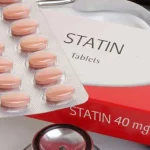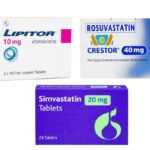Taking Statins Post-“Bleeding” Stroke May Help Prevent Subsequent Strokes – Study

Using statin medication to lower cholesterol levels following a hemorrhagic stroke may reduce the likelihood of experiencing a subsequent stroke caused by a blood clot, according to recent research. Dr. David Gaist, a member of the American Academy of Neurology from the University of Southern Denmark in Odense, led the study. He explained that prior research produced conflicting outcomes regarding stroke risk in individuals taking statins after a hemorrhagic stroke, prompting further investigation.
The study examined whether statin usage following a hemorrhagic stroke was associated with an increased risk of any subsequent stroke, including both hemorrhagic and ischemic strokes. Notably, those who utilized statins exhibited a diminished risk of stroke, particularly ischemic strokes, without any change in the risk of hemorrhagic strokes.
Intracerebral hemorrhage results from bleeding within the brain, while ischemic strokes arise due to the blockage of blood flow to the brain, constituting the most prevalent stroke type. The research encompassed the health records of over 15,000 individuals who experienced their initial hemorrhagic stroke.
Researchers monitored these patients from 30 days after their hemorrhagic stroke until the occurrence of another stroke, death, or the conclusion of the follow-up period, which averaged 3.3 years. Prescription data, including medications like atorvastatin and simvastatin, were employed to assess statin usage.
Several comparisons were conducted. Firstly, more than 1,900 individuals who experienced another stroke were compared to 7,400 individuals who did not endure a second stroke. Among those who had another stroke, approximately 39% used statins, compared to 41% of those who remained stroke-free. After adjusting for factors such as high blood pressure, diabetes, and alcohol consumption, statin use was linked to a 12% reduced risk of a subsequent stroke.
Secondly, over 1,000 individuals who suffered an ischemic stroke were compared to more than 4,000 individuals without another stroke. Among those who experienced an ischemic stroke, around 40% used statins, compared to 42% of those who did not have another stroke. Statin use was associated with a 21% lower risk of an ischemic stroke following the initial hemorrhagic stroke.
Lastly, nearly 1,000 individuals who experienced a recurrent hemorrhagic stroke were compared to more than 3,700 individuals who did not experience another stroke. Among those with a recurrent hemorrhagic stroke, 39% took statins, while 41% of those without another stroke used statins. After adjustments, researchers did not find a connection between statin usage and recurrent hemorrhagic stroke.
Dr. Gaist emphasized the study’s encouraging findings for individuals taking statins after a hemorrhagic stroke, indicating a reduced risk of experiencing another stroke, specifically ischemic stroke. Importantly, there was no heightened risk of recurring hemorrhagic stroke associated with statin use. However, Dr. Gaist noted the need for additional studies to validate these findings.
It is important to note that the study’s limitations include its exclusive focus on the Danish population, which may limit its generalizability to other populations. The research results were published online on August 30 in the journal Neurology. You may also find useful information on Study Shows Statins Reduce Heart Risks for People Living with HIV





